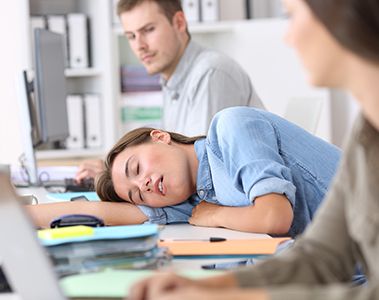Narcolepsy
Narcolepsy is a sleep disorder of neurological origin characterized by excessive daytime sleepiness, accompanied in most cases by cataplexy (muscle hypotonia attacks). The prevalence of the disease in Europe is 3-5 per 10000 inhabitants. It generally appears between the second and third decades of life. There is an important genetic component, as several members of the same family may be affected (incidence of 1-2% in first-degree relatives).

Learn more about this pathology:
CHARACTERISTICS OF THE DISORDER

- Excessive daytime sleepiness: is the main problem for these patients. It occurs daily, although in a non-permanent way, both in monotonous situations (reading, watching TV) and in inappropriate situations (eating, driving). Episodes may last from minutes to hours, presenting as either progressive or sudden attacks of irresistible sleep.
- Muscular hypotonia crises: are typical of the disease, and consist of episodes of sharp decline in muscle tone, without loss of consciousness, when facing strong emotions (fright, laughter, arguments). They can occur in any muscle in the body, sometimes imperceptibly (unobtrusive feeling of “laziness”), or more intensely, with a fall to the ground. They can last from seconds to minutes.
- Hypnagogic/Hypnopompic hallucinations: usually occur in the sleep-wake transition (while falling asleep or waking up). The patient has unreal perceptions (auditory, visual or tactile).
- Sleep paralysis: is the inability to move extremities or the whole body just before falling asleep or waking up. It is often accompanied by hypnagogic/hypnopompic hallucinations.
- Fragmented sleep: the patient with narcolepsy usually awakens frequently throughout the night. Parasomnias (nightmares, sleepwalking, speaking in dreams, episodes of psycho-motor agitation) are also frequent. The “rapid eye movement” REM sleep phases appear prematurely.
Other common symptoms are
- Automatic behavior: patients engage in activities (e.g., car trips) without remembering them later.
- Refreshing naps: many times, if the subject is asleep for a few minutes, hypersomnolence significantly improves.
- Subjective feeling of memory loss and lack of concentration.
- Feeling of tiredness and fatigue.
- Mood disorders.
- Blurred vision.
- Eating disorders (episodes of bulimia).
Diagnosis
A complete clinical history, to rule out other problems (neurological disorders), sleep apnea syndrome, restless legs syndrome, medications, etc.
General analysis and genetic study (HLA DR B1 * 1501, DQB1 * 0602, DQA1 * 0102).
Nocturnal polysomnography: sleep study to see the structure and time that it takes to enter the REM phase, as well as to rule out other causes of hypersomnolence.
Multiple latency test: held in the morning, after the overnight study, and serves to detect the level of daytime hypersomnolence and the abnormal presence of episodes of REM sleep.
Levels of hypocretins in cerebrospinal fluid (lumbar puncture): form part of the diagnosis and are the main cause of the disease. In narcoleptic patients, they are diminished in the nervous system.
Treatment
When it comes to treating the disorder, several factors are taken into account, such as age, associated diseases, lifestyle and impact of sleepiness and/or drugs on the quality of life of the patient.
Sleep hygiene
A regular sleep schedule is key along with avoiding alcohol and medications that depress the central nervous system. Physical exercise, increasing the number of hours of nighttime sleep, and performing scheduled short naps during the day is recommended.
Pharmacological treatment
- Stimulants: methylphenidate, modafinil. These drugs help to control excessive daytime sleepiness.
- Serotonin reuptake inhibitors: are used to reduce the phases of REM sleep and control cataplexies, hypnagogic hallucinations, and sleep paralysis.
- Sodium oxybate: used to treat cataplexy, hypnagogic hallucinations, and sleep paralysis. It also improves the quality of sleep, which reduces daytime sleepiness.
In any case, each patient should be evaluated individually, taking into account the impact of symptoms on their daily activities, and side effects of drug treatment.